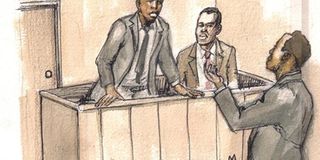Death following anaesthesia: Medical workers defence

What you need to know:
- A doctor and an anaesthetist were charged before court with causing the death of a patient by rash and negligent act.
- Both medical workers told court they were not guilty of the crime of causing death of the 34-year-old woman patient during surgery.
The patient’s primary doctor gave unsworn evidence in court. This means that he did not take an oath to tell the truth. It also meant that he could not be cross -examined. The doctor admitted to seeing the patient at his facility and recommending her for laparoscopic surgery. The doctor told court that he recommended the patient to another doctor who was an expert in laparoscopic surgery.
He, however, denied going to theatre with the patient but instead went to his office. He, therefore, denied knowledge of the surgical procedure that took place. He, however told court that he was called to theatre 30 minutes later when the patient suffered a cardiac arrest and resuscitation was going on. He joined the resuscitation team but their efforts were futile; the patient died.
The evidence of the anaesthetist and technician
The anaesthetist, who testified under oath, told court that he had a clean record of more than 700 operations with this particular hospital without any incident. In addition he had a number of other successful operations in other hospitals. He told court that what happened to this particular patient was most unfortunate but that he did not believe the cause of death was correctly established by the pathologist as his equipment was in good working condition.
He told court he inserted the tube in the patient’s trachea and thereafter the surgeon made an incision into the patient’s abdomen. However, 20 minutes into the operation, the anaesthetist started seeing wrong readings on his screen and the alarm went off. He stated that he then turned off his anaesthetic agents and then gave the patient pure oxygen and started resuscitating the patient. According to the anaesthetist the patient would not have lived for 30 minutes if the tube had been wrongly inserted. He further testified that the surgeon was satisfied with the anaesthesia given before commencing the surgery.
A theatre technician testified on behalf of the defence and told court that all the equipment in theatre that day was in good working condition and that the patient’s primary doctor was not in theatre with them during this particular operation.
Submissions
The doctor’s lawyer implored court to acquit the doctor as the section of the law under which he was charged did not support the particulars of the offence. The lawyer also told court that prosecution had failed to prove a common intention between the doctor and the anaesthetist to commit the said crime. And finally the lawyer told court that his client was not at the scene of crime at the commission of the crime; that is, the doctor was not in theatre during the time of the operation.
The anaesthetist’s lawyer asked court to acquit his client. His argument was that the anaesthetist performed his duty very well and that was why the operation commenced. Had there been a wrong intubation then the surgeon would not have carried out the operation for 10 minutes. The lawyer also told court the cause of death was intra-operative neurogenic shock and not the absence of oxygen in the body. He also added that the postmortem report was incomplete since no histology or toxicology were submitted by the prosecution.
Health workers have case to answer
Court declared that two medical workers had a case to answer at the conclusion of the prosecution’s case against them when a 34-year-old woman in the care of the two health workers died at the start of an operation to remove a uterine fibroid. The two health workers were charged in court with causing death by a rash and negligent act when the tube to administer oxygen and anaesthesia was wrongly inserted into the patient’s oesophagus instead of her trachea. The patient’s death was directly attributed by the pathologists who performed the postmortem examination on the body of the patient to the wrong insertion of this tube.
To be continued




